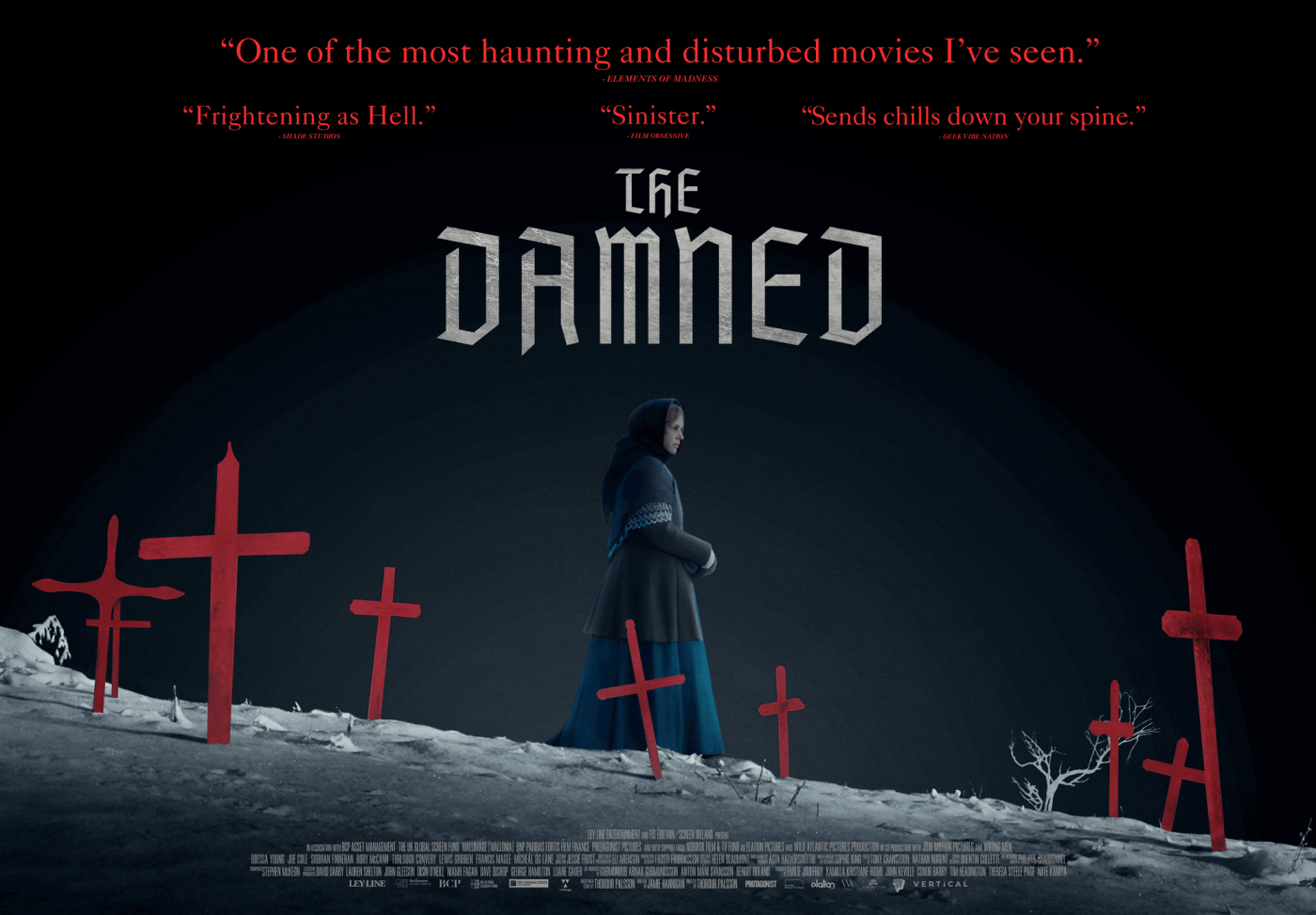Movie Review: The Damned (2024)

The Damned is a gripping and atmospheric horror film directed by Thordur Palsson, which masterfully combines psychological dread with folklore horror to tell a tale of survival, isolation, and guilt in the harsh, unforgiving Arctic. Starring Joe Cole and Odessa Young, the film explores the descent into madness as an isolated community is haunted by both supernatural forces and the moral consequences of their actions.
Set in a desolate 19th-century Arctic fishing outpost, The Damned follows Eva (Odessa Young), a young widow struggling to lead a dwindling crew of fishermen through a brutal winter. The film’s setting is one of its greatest strengths, as the isolated landscape and harsh elements create a palpable sense of dread from the outset. The outpost, surrounded by dangerous waters and jagged rocks known as “the Teeth,” feels like a character itself — a cold, merciless entity trapping the crew with no escape.
The narrative begins with a tragic shipwreck that sets off the film’s central conflict. Eva and her crew hear the screams of the ship’s survivors but, due to their own dwindling supplies, make the difficult decision to let them perish. This moral compromise haunts the characters throughout the film, as guilt and paranoia manifest in terrifying ways. The film does a fantastic job of exploring how guilt can fester and turn into something monstrous, making viewers question whether the true horror lies in supernatural forces or in the characters’ own psyches.
Odessa Young delivers a standout performance as Eva. She captures the character’s complexity — a woman hardened by grief and survival, yet vulnerable to the creeping dread that overtakes the outpost. Joe Cole, as Daníel, provides a
grounded counterpoint to Eva’s spiraling paranoia, and their evolving relationship adds an emotional anchor to the story.
The film’s supernatural element is rooted in Nordic folklore, particularly the legend of the draugr — undead revenants fueled by hatred and rage. The draugr serves as both a literal and metaphorical threat, representing the consequences of moral failings and the dangers of superstition. The film keeps its horror subtle and psychological for much of its runtime, relying on atmosphere, eerie dreams, and unsettling imagery to build tension. When the draugr finally makes its full appearance, it is grotesque and terrifying. The final twist is a haunting commentary on how fear and guilt can distort reality.

Director Thordur Palsson’s visual style is stunning. The film’s cinematography captures the bleak beauty of the Arctic landscape, using natural light and shadow to heighten the oppressive atmosphere. The long shots of icy cliffs, endless snow, and the ever-present Teeth create a sense of isolation that weighs heavily on both the characters and the audience. The use of sound is equally effective; the howling wind, creaking wood, and distant screams enhance the film’s sense of dread and uncertainty.
The pacing of The Damned is deliberate, with the first half focusing on building tension and character dynamics before descending into full-blown horror. Some viewers may find the slow build challenging, but those who appreciate atmospheric horror will be rewarded by the film’s chilling climax. The film’s themes — isolation, survival, guilt, and the clash between superstition and reason — are explored thoughtfully and woven seamlessly into the narrative.
One of the film’s most compelling aspects is its exploration of cultural and religious beliefs. The crew members bring different worldviews to the story, from Helga’s superstitious warnings about the draugr to Jonas’s Christian prayers for salvation. These conflicting beliefs highlight the tension between tradition and modernity, faith and reason. The film ultimately suggests that no belief system can fully protect one from the horrors of human nature.
Ultimately, The Damned is a beautifully crafted and deeply unsettling film that lingers long after the credits roll. It combines folklore, psychological horror, and moral ambiguity to create a unique and thought-provoking experience. Fans of atmospheric horror, particularly those interested in folklore and historical settings, will find much to appreciate in this chilling tale.
Verdict: 8.5/10
The Damned is a haunting, slow-burn horror film that masterfully blends atmosphere, folklore, and psychological dread. While it may not be for everyone, its exploration of guilt, isolation, and cultural beliefs makes it a standout entry in modern horror. The film’s chilling visuals, strong performances, and moral complexity ensure it will leave a lasting impression.
VERSIONE ITALIANA
Recensione del film: The Damned (2024)
Un avvincente e atmosferico film horror diretto da Thordur Palsson
The Damned è un avvincente e atmosferico film horror diretto da Thordur Palsson, che combina magistralmente il terrore psicologico con l’orrore folkloristico per raccontare una storia di sopravvivenza, isolamento e senso di colpa nelle dure e implacabili terre artiche. Con protagonisti Joe Cole e Odessa Young, il film esplora la discesa nella follia di una comunità isolata, perseguitata sia da forze soprannaturali che dalle conseguenze morali delle proprie azioni.
Ambientato in un desolato avamposto di pesca artico del XIX secolo, The Damned segue Eva (Odessa Young), una giovane vedova che lotta per guidare un gruppo sempre più ridotto di pescatori attraverso un rigido inverno. L’ambientazione è uno dei punti di forza del film: il paesaggio isolato e gli elementi naturali ostili creano un senso palpabile di terrore sin dalle prime scene. L’avamposto, circondato da acque pericolose e rocce frastagliate note come "i Denti," sembra quasi un personaggio a sé stante — un’entità fredda e spietata che intrappola l’equipaggio senza via di fuga.
La narrazione si apre con un tragico naufragio che dà il via al conflitto centrale del film. Eva e i suoi uomini sentono le urla dei sopravvissuti della nave, ma, a causa delle loro scarse risorse, prendono la difficile decisione di lasciarli morire. Questo compromesso morale perseguita i personaggi per tutta la durata del film, con il senso di colpa e la paranoia che si manifestano in modi terrificanti. Il film esplora con maestria come il senso di colpa possa crescere e trasformarsi in qualcosa di mostruoso, facendo interrogare lo spettatore su dove risieda il vero orrore: nelle forze soprannaturali o nella psiche dei personaggi.
Odessa Young offre una performance straordinaria nel ruolo di Eva, catturando la complessità del personaggio: una donna indurita dal dolore e dalla lotta per la sopravvivenza, ma vulnerabile al terrore crescente che invade l’avamposto. Joe Cole, nel ruolo di Daníel, fornisce un contrappunto equilibrato alla paranoia di Eva, e la loro relazione in evoluzione aggiunge un ancoraggio emotivo alla storia.
L’elemento soprannaturale del film è radicato nel folklore nordico, in particolare nella leggenda del draugr — spettri non morti alimentati da odio e rabbia. Il draugr rappresenta una minaccia sia letterale che metaforica, simbolo delle conseguenze delle colpe morali e dei pericoli della superstizione. Per gran parte della durata del film, l’orrore rimane sottile e psicologico, basandosi sull’atmosfera, sui sogni inquietanti e sulle immagini disturbanti per costruire tensione. Quando il draugr appare finalmente in tutto il suo orrore, è grottesco e terrificante. Il colpo di scena finale è un commento agghiacciante su come la paura e il senso di colpa possano distorcere la realtà.
Lo stile visivo del regista Thordur Palsson è straordinario. La fotografia del film cattura la cupa bellezza del paesaggio artico, utilizzando la luce naturale e le ombre per amplificare l’atmosfera opprimente. Le lunghe inquadrature di scogliere ghiacciate, neve infinita e i sempre presenti Denti creano un senso di isolamento che grava sia sui personaggi che sul pubblico. L’uso del sonoro è altrettanto efficace: il vento ululante, il legno che scricchiola e le urla lontane intensificano il senso di angoscia e incertezza del film.
Il ritmo di The Damned è deliberatamente lento, con la prima metà concentrata sulla costruzione della tensione e sulle dinamiche tra i personaggi prima di scivolare nell’orrore puro. Alcuni spettatori potrebbero trovare la progressione lenta difficile da affrontare, ma chi apprezza l’horror atmosferico sarà ricompensato dal climax agghiacciante del film. I temi del film — isolamento, sopravvivenza, senso di colpa e il conflitto tra superstizione e ragione — sono trattati con intelligenza e intrecciati con naturalezza nella narrazione.
Uno degli aspetti più affascinanti del film è la sua esplorazione delle credenze culturali e religiose. I membri dell’equipaggio portano visioni del mondo diverse nella storia, dai moniti superstiziosi di Helga sul draugr alle preghiere cristiane di Jonas per la salvezza. Queste credenze contrastanti evidenziano la tensione tra tradizione e modernità, fede e ragione. Il film suggerisce infine che nessun sistema di credenze può proteggere completamente dagli orrori della natura umana.
The Damned è, in definitiva, un film meravigliosamente realizzato e profondamente inquietante che resta impresso a lungo dopo i titoli di coda. Combina folklore, orrore psicologico e ambiguità morale per creare un’esperienza unica e stimolante. Gli appassionati di horror atmosferico, in particolare quelli interessati al folklore e alle ambientazioni storiche, troveranno molto da apprezzare in questa storia agghiacciante.
Voto finale: 8,5/10
The Damned è un horror a combustione lenta, inquietante, che mescola abilmente atmosfera, folklore e terrore psicologico. Sebbene non sia adatto a tutti, l’esplorazione del senso di colpa, dell’isolamento e delle credenze culturali lo rende un’opera unica nel panorama dell’horror moderno. Le sue immagini inquietanti, le interpretazioni intense e la complessità morale assicurano un’impressione duratura.





